
Red wine is a type of wine made from dark-colored grape varieties. The actual color of the wine can range from intense violet, typical of young wines, through to brick red for mature wines and brown for older red wines. The juice from most purple grapes is greenish-white, the red color coming from anthocyan pigments present in the skin of the grape; exceptions are the relatively uncommon teinturier varieties, which produce a red-colored juice. Much of the red-wine production process therefore involves extraction of color and flavor components from the grape skin. It is a delicacy around the world.

Airén is a variety of Vitis vinifera, a white grape commonly used in winemaking. This grape is native to Spain where it represents almost a quarter of all grapes grown. As of 2010, Airén was estimated to be the world's 3rd most grown grape variety in terms of planted surface, at 252,000 hectares, down from 306,000 hectares in 2004, where it held 1st place, although it is almost exclusively found in Spain. Since Airén tends to be planted at a low density, several other varieties are more planted in terms of number of vines.
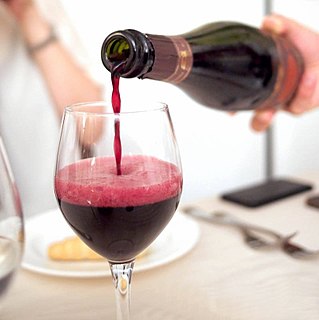
Lambrusco is the name of both an Italian red wine grape and a wine made principally from said grape. The grapes and the wine originate from four zones in Emilia-Romagna and one in Lombardy―principally around the central provinces of Modena, Parma, Reggio-Emilia, and Mantua. The grape has a long winemaking history, with archaeological evidence indicating that the Etruscans cultivated the vine. In Roman times Lambrusco was highly valued for its productivity and high yields, with Cato the Elder stating that produce of two thirds of an acre could make enough wine to fill 300 amphoras.

Aglianico is a black grape grown in the southern regions of Italy, mostly Basilicata and Campania. It is considered with Sangiovese and Nebbiolo to be one of the three greatest Italian varieties. Aglianico is sometimes called "The Barolo of the South" due to its ability to produce highly refined, complex fine wines like the famous Piedmont wine, Barolo.
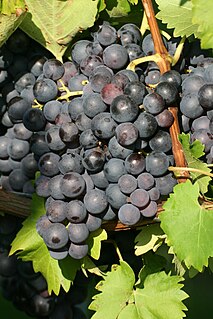
Trollinger, Schiava, or Vernatsch, is a red German/Italian wine grape variety that was likely first originally cultivated in the wine regions of South Tyrol and Trentino, but today is almost exclusively cultivated on steep, sunny locations in the Württemberg wine region of Baden-Württemberg. It is primarily known under the synonyms Trollinger in Germany, Vernatsch in South Tyrol and Schiava in other Italian regions. As a table grape the variety is sometimes known as Black Hamburg, which is commonly confused with the similar synonym for Black Muscat—a variety that is actually a cross of Trollinger and Muscat of Alexandria.

Vitis rupestris is a species of grape native to the United States that is known by many common names including July, Coon, sand, sugar, beach, bush, currant, ingar, rock, and mountain grape. It is used for breeding several French-American hybrids as well as many root stocks. The cultivar known as Rupestris St. George has been widely used in breeding and as a root stock; it is perhaps the best known.
Freisa is a red Italian wine grape variety grown in the Piedmont region of north-west Italy, primarily in Monferrato and in the Langhe, but also further north in the provinces of Turin and Biella. Freisa is a vigorous and productive vine whose round, blue-black grapes are harvested in early October. The three-lobed leaves are relatively small and the bunches are elongated in form. By the 1880s it had become one of the major Piedmontese grapes, and in that period its cultivation was stimulated by the vine’s resistance to the downy mildew caused by the Plasmopara viticola fungus. Wines made from the Freisa grape are red and usually somewhat sweet and lightly sparkling, or foaming. Still and fully sparkling versions are also produced, however, as are dry and more decidedly sweet styles. In the Canavese there is also a rosé which can be made primarily from Freisa according to Denominazione di origine controllata (DOC) regulations.
Raboso is a red wine grape grown primarily in the eastern part of Veneto. It is also called Raboso Piave, from the name of a river near where it is grown. It produces deep-colored wine, with notably high levels of tannin and medium alcohol content and high acid. The name raboxo in the native Venetian language means "angry", because angry is the sensation in the mouth when this wine is drunk young. Raboso was in the past the most cultivated grape variety of eastern Veneto; Venetian navigators called it vin de viajo, "wine of travel", because it was the most resistant to aging and transport. Its popularity decreased in the 20th century, and today the vineyards of Raboxo are just 1–2% of the total amount of vineyards in Veneto.
Moristel is a minor Spanish red grape variety. It is mainly found in the autonomous region of Aragon and is one of the authorized varieties of the Somontano Denominación de Origen (DO). It has medium-sized, compact bunches with medium-sized, cylindrical-shaped berries with a blue hue. Traditionally it has been used for blending with other varieties to add body and colour to the wine.
Uva di Troia is a red wine grape variety grown in the Italian region of Apulia, particularly in the areas around Andria and Barletta, and in the Province of Bari.
Bombino bianco is a white Italian wine grape variety planted primarily along Italy's Adriatic coast line, most notably in Apulia. The vine is prone to high yields and often produces neutral flavor wines. The grape is known under many synonyms throughout Italy including Debit and Pagadebit, names which came from the grape's reputation for being a high yielding and reliable crop for vineyard owners to grow that would assure them that on each vintage they could pay off their debts.
Uva Rara is a red Italian wine grape variety that is grown in the Piedmont and Lombardy wine regions of northern Italy. The grape is a permitted blending variety along with Nebbiolo in the Denominazione di Origine Controllata e Garantita (DOCG) wines of Ghemme. In the Denominazione di Origine Controllata (DOC) wine region of Oltrepò Pavese the grape is often blended with Barbera and Croatina. While Uva Rara's name means "rare grape" in Italian, the variety is actually widely planted with 608 hectares of the vine recorded in Italy in 2000.
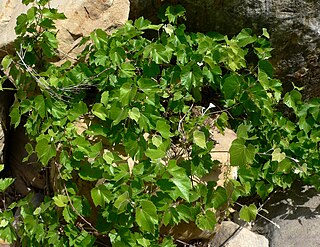
Vitis arizonica is a North American species of wild grape. It is a deciduous vine.
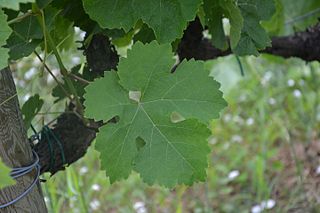
Gringet is an autochthonous white wine grape from Haute-Savoie, France that is used as both a blending grape and for varietal wines. It is mainly used in the Ayze AOC sparkling wine production. The wine grape grown on the hills above the lower Vallee de l'Arve, in the French Alps (Haute-Savoie).

Thomcord is a seedless table grape variety and a hybrid of the popular Thompson Seedless or Sultanina grape and Concord grape. Thomcord was developed in 1983 by Californian grape breeders working for the Agricultural Research Service (ARS), an agency of the United States Department of Agriculture (USDA), as part of a test to better understand a new seedless grape breeding procedure.
Forcallat tinta is a red Spanish wine grape variety that is native to the Castile-La Mancha region of central Spain, as well as in Alicante and Valencia provinces in the Valencian Community. The name of the cultivar means "forked" in Valencian, which probably refers to the bunches having a wing or shoulder, rather than a tendency to produce forked vines as suggested by Favà. It tends to produce pale-colored wines and is most often used as a minor blending component in Vino de la Tierra (VdlT) wines. It is an authorized variety in the Comunitat Valenciana, where it has become almost extinct and only a few wine makers like Rafael Cambra are making efforts to recover it, with interesting proposals like La forcallà d'Antònia. Extant plots are found in Fontanars dels Alforins, La Font de la Figuera, Villena and probably Moixent, though the cultivar was once a prevailing one in La Vall d'Albaida and Alto Vinalopó regions. Bodega la Encina in Villena (Alicante) with vineyards in neighbouring Almansa (Albacete) also works with the variety, offering wines from biodinamic and organic farming. DNA profiling conducted in the early 21st century determined that the white berried Forcallat blanca grape is a distinct variety and not a color mutation of Forcallat tinta. The white cultivar Trepadell is also called Forcallat blanc in the village of La Font de la Figuera, with only one remaining plot of about 600 plants. Trepadell is also present in the Marina Alta region and has been elaborated by Curii uvas & vinos.
Termarina rossa is a red Italian wine grape variety that is grown in the Emilia-Romagna region of northern Italy. The grape is unique among Vitis vinifera varieties in that it is naturally seedless. Historically Termarina rossa was grown in the provinces of Parma and Reggio Emilia for use in production of jams and saba, a sweet syrup, made from boiling the must but today it is used as a blending variety in some of Indicazione geografica tipica (IGT) wines of the area.
Barbera del Sannio is a red Italian wine grape variety that is grown in the Campania region of southern Italy. Despite the similarities in name and appearance, the grape has no close genetic relationship with the Piedmont wine grapes Barbera or Barbera bianca or the Sardinian wine grape Barbera Sarda and is, instead, more closely related to the Campanian varieties Casavecchia and Catalanesca and the Apulian grape Nero di Troia.

Teran grape is a variety of red grape from Istria, Croatia. It is mostly found in western part of Istria. It is a late-ripening variety and grows in large clusters with densely packed berries. Berries have highly resistant skin and deep ruby red color. The vine requires a lot of sun but less water. It is sensitive, both to extremely strong sun and to excessive humidity (botrytis). When the grapes are fully ripe and all other needed conditions are met, a very good quality red wine can be made from them. Its alcohol content is usually between 11 and 14%.
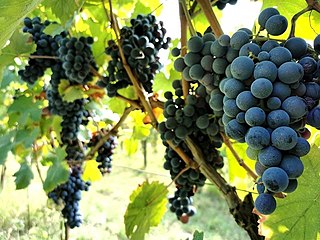
Gamba di Pernice, or the officially used name Gamba Rossa, is a red Italian wine grape variety from the Piedmont region. Translated from Italian, its name means "partridge leg" and is a reference to the red colored stalks of the vines. The grapes is mainly used for making DOC Calosso, a small volume red varietal wine which was granted Denominazione di Origine Controllata (DOC) status in 2011. The current DOC recognized area of production for the wine covers only about 10 hectares of vines in the municipalities of Calosso, Costigliole d'Asti and Castagnole Lanze in the Asti Province[1]. Gamba di Pernice is therefore one of the lowest production varietal wines in Italy with its own DOC. Total production is around 30 000 bottles per year (2017) [3]. Although lightly colored, Gamba di Pernice wines have concentrated flavors with a spicy, herbal character and the ability to age well[2].











